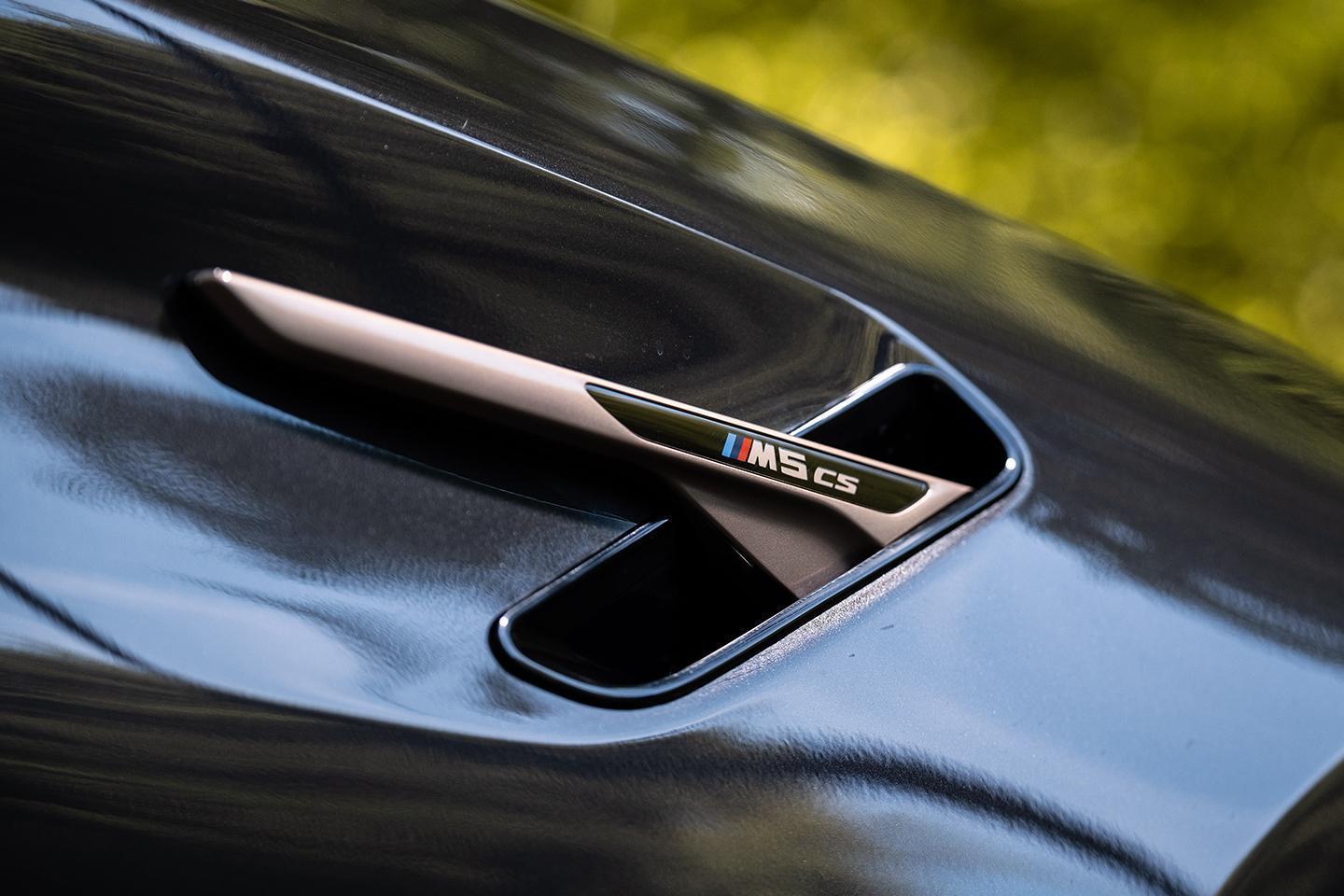After four years and three variants – the M2, M3, and M4 – the formula for the BMW CS is well established. As the model nears the end of its lifecycle, it builds upon the Competition M car with more power, enhanced chassis focus, stylish wheels, and a jaw-dropping price tag. Given the quality of the Competition models and the improvements made, it’s no surprise that modern CS BMWs have been exceptional – the M2 was one of our cars of 2020. Still, questions about their value for money linger.
At first glance, the M5 CS seems like more of the same. It delivers an extra 10hp over the Competition, mirroring the gains made by the M3 and M4, bringing the total to 635hp (making it the most powerful BMW ever). It also features gold-forged wheels, a signature of the M2, and comes with a hefty price tag – £40,000 more than the M5 Competition, at £140,780. On the surface, it’s just another BMW CS.
However, the M5 stands apart. Unlike the M2, M3, and M4, the M5 isn’t nearing the end of its life; it was only introduced in 2018 and was recently updated. Some might suggest BMW is capitalizing on the opportunity before performance V8 saloons like this one become obsolete, particularly as the brand shifts toward electric i models. With this “end-of-an-era” vibe in mind, BMW has given the M5 CS a more thorough overhaul than other CS models. The car has shed 70kg, thanks to standard ceramic brakes, lighter wheels, and a remarkable CFRP bonnet. It features four individual bucket seats, a lower ride height, reworked dampers, and a new exhaust system. Oh, and it’ll hit 189mph – a feature that’s usually optional.
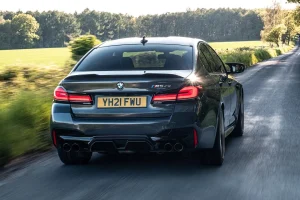
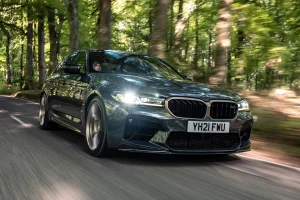
A 40 percent price increase is significant, and it’s understandable to have concerns—until the CS is sitting in front of you, making the M5 Competition seem as exciting as a 530e. The upgrades might not sound dramatic on paper (the ride height drops by just 7mm), but when combined with the new splitter, wheels, bonnet vents, carbon accents, and, of course, the gold details, it creates a true sense of occasion in person. The CS looks particularly menacing in grey, yet it remains handsome—exactly how an M car should appear.
For some, the interior might represent everything wrong with this type of car: a track-focused version of a five-meter-long luxury saloon. The slim front seats are electrically adjustable, with a Nürburgring outline embossed in the leather, and Alcantara on the wheel that controls radar cruise and wireless CarPlay. It’s a bit conflicted, and it’s easy to be critical based on photos. However, the CS defies expectations in real life. The seats, seemingly borrowed from the new M3, are just as comfortable as they are supportive, and it’s hard not to smile when you spot two very similar seats for rear passengers. The wheel feels fantastic to hold, and the driving position would put some sports cars to shame. It may not be worth an extra £40k over the M5 interior (that would be a tall order), but it’s hard to imagine many complaints.
In terms of driving, the M2, M3, and M4 CS have largely felt like improved Competitions on sticky tyres. But with the M5, the CS feels like a genuine step up from the Competition. Considering how well the latest M5 has been received, it’s clear that this car is something special.
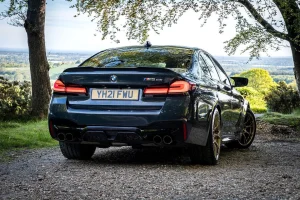
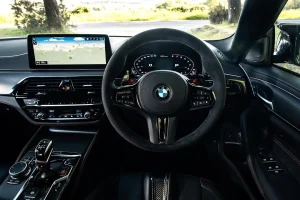
Let’s be clear: it doesn’t feel any faster. Removing 70kg from an M5 is like taking the cherry off a trifle, and an extra 10hp is hardly noticeable, especially when the M5 already had more power than a Ferrari Roma. While the stats show a slight improvement, shaving half a second off the 0-124mph time (10.3 seconds versus 10.8) doesn’t create any noticeable difference. What does make a difference, however, are BMW’s sound and exhaust adjustments. The 4.4-litre twin-turbo V8 was never the most soulful engine, but the changes made for the CS have given it a much richer tone. It’s not thunderous, but it’s certainly more melodic than before. While it may still feel a little too refined to be truly authentic, this is by far the best-sounding M5 with this engine—finally, after a decade.
Not only is this CS the best-driving M5 with this engine, but it could also be one of the best-driving M cars, full stop. It feels as though all the lessons from previous models have been incorporated into this car, with some influence from the new M3, making it arguably the most well-rounded of the CS models. In short, it’s pretty impressive.
On paper, the changes might seem modest, but the results are tangible: this is an M5 that manages to be both more comfortable and sharper than the Competition—a remarkable feat. BMW claims the dampers have been reworked to account for the reduced weight, but it’s important to consider how much of that weight loss is in unsprung mass, which likely contributes to the ride improvement. The CS is still firm, of course, but it’s noticeably more accommodating than the Competition or a new M3 in Comfort mode. Interestingly, the Sport suspension mode, which BMW claims is “perfectly suited to sporty driving on country roads and offers the ideal handling profile for Nurburgring laps,” feels only slightly stiffer than Comfort mode. You’ll need to select Sport Plus if you’re looking to feel any real discomfort.


When it comes to the dynamic parameters, it’s important to note that the M5 does without the M8’s Integrated Brake System (a positive), leaving powertrain, suspension, steering, and 4WD to adjust. For the CS, the best setup seems to mirror the Competition (4WD Sport, sharp powertrain, and comfort-focused suspension), though it’s clear that this car simply works better than the Competition. It feels more agile, with steering that offers the precision and clarity of the new M3—something that’s missing from the standard M5, and provides a level of confidence that’s fast becoming a hallmark of the CS. The seats offer a better connection to what the car is doing, the brakes feel even more powerful with a bit less weight, and 4WD Sport remains exciting with a more focused setup. Yet, it will still cruise home just as comfortably as any other M5. All this, despite the incorrect tyres—our test car was fitted with Michelin Pilot Sport 4S tyres, rather than the Pirelli P Zero Corsa that the M5 is designed for. So, just imagine how good it could be with the proper tyres.
Put simply, the M5 CS drives a lot like the new M3—intended as a compliment—with the added bonus of a more refined V8 and a less punishing ride. It doesn’t feel any heavier than the 3 Series, being agile and responsive in a way that belies its weight. The changes to the M5 CS feel more significant than those in other CS BMWs, which helps justify its premium. In the past, a set of Cup 2 tyres may have brought a similar improvement, but the M5 CS offers a more tangible step up.
That said, it’s hard not to be dismissive of the idea of a £140k BMW 5 Series. While it’s clearly an improvement over the standard model, even the most dedicated enthusiast would be hard-pressed to argue that it’s a night-and-day difference. What truly elevates the M5 CS, though—beyond its driving performance and without needing to take it on track—is the intangible experience: how it makes you feel when you look at it, sit in it, and drive it down the road, even at much lower speeds than it’s capable of. You’ll find yourself lifting the lightweight bonnet to show off the ‘M5 CS’ embossed in the carbon fibre, admiring the yellow-tinted lights, offering to let anyone interested sit in the rear bucket seats, and protecting those wheels like they’re your own children. This is an event car, far more than any other M5. The fact that it’s also better to drive—and could well be the last of its kind—seems almost like a fortunate bonus. And if the price is hard to swallow, remember that the Ultimate Packed Competition is only £20k cheaper. In the end, by the time your journey is over, you won’t question the lavish cost. And that’s perhaps the highest compliment the CS can receive.
Engine: 4,395cc, V8, twin-turbocharged
Transmission: 8-speed auto, all-wheel drive
Power (hp): 635@6,000rpm
Torque (lb ft): 553@1,800-5,950rpm
0-62mph: 3.0 seconds
Top speed: 189mph
Weight: 1,825kg (DIN, without driver, 1,900kg EU)
MPG: 25-25.5
CO2: 253-258g/km
Price: £140,780
Image credit | Harry Rudd


